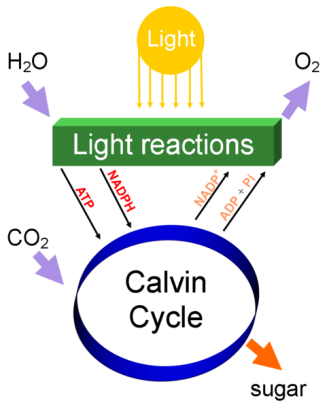Getting the Good Stuff
Helianthus annuus is an autotroph meaning that it makes its own food via photosynthesis. The leaves of a sunflower are phototropic, they turn to follow the rays of the sun. This increases the amount of light intercepted and leads to increased photosynthesis. This adaptation was made because the sunflowers primary source of nutrition is from conducting photosynthesis.
Photosynthesis is the process of using energy from the sun to produce sugar which cellular respiration then uses to create ATP, this energy fuels the plant. The image to the right further identifies where water and carbon dioxide enter the cycle and where oxygen and sugar is produced.
Water enters through the root and is transported up the stem by specialized cells called the xylem. Land plants have stomata, a unique adaptation to avoid desiccation. The stomata allows the oxygen produced during photosynthesis to leave the leaf and carbon dioxide to which is used during photosynthesis to enter. Although it is necessary for these gases to be entering and exiting the leaves, it also has a downfall, as much water is lost during the process. The sugar that is produced during photosynthesis is then distributed throughout the plant via the phloem.
Travel through a detailed description of water and mineral movement thorough a plant by viewing Transport.
